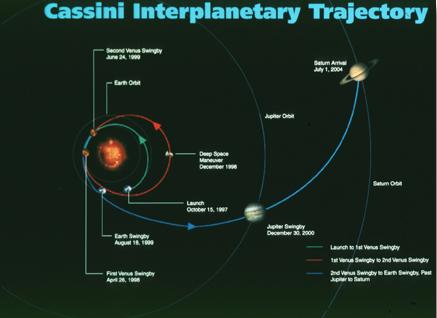Interplanetary Trajectory

| Language |
|
|---|
This graphic depicts the interplanetary flight path beginning with launch
from Earth on 15 October 1997, followed by gravity assist flybys of Venus
(26 April 1998 and 24 June 1999), Earth (18 August 1999), and Jupiter
(30 December 2000). Saturn arrival 1 July 2004 marked
the beginning of a four-year prime mission orbital tour of the Saturn System.
The gravity assist flybys of the different planets are designed to increase
the spacecraft's velocity relative to the Sun so it can reach Saturn. During
these planetary flybys, there is an exchange of energy between the planet
and the spacecraft that accelerates the latter and changes its velocity
direction relative to the Sun.
With the use of the VVEJGA (Venus-Venus-Earth-Jupiter Gravity Assist)
trajectory, it takes 6.7 years for the Cassini spacecraft to arrive at
Saturn. The spacecraft will log 5 billion kilometers (over 3 billion miles)
during its 6.7 year cruise. This complex trajectory design means that the
spacecraft must be capable of withstanding the thermal environment both
inside the orbit of Venus (40 C) and at Saturn (-190 C).
